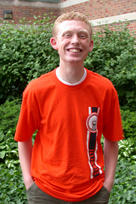Summer School Diaries
Diary of the 2003 Summer School on Theoretical and Computational Biophysics
Monday, June 9 -- Craig Jolley
By Monday morning everyone had returned from their weekend diversions safe and sound and we were ready to launch into a fresh new day in the world of computational biophysics.
I'll have to admit that, as a newcomer to the field, the morning lectures were a little hard for me to follow -- the lectures during the second week of the summer school were generally more technical and advanced than those in the first week. The biggest things that I took away from the morning's lectures were a general "lay of the land" for empirical force field, and a deepened sense of how complicated this sort of research really is. After the first few days of the summer school, I had the impression that MD was going to be relatively easy -- just a matter of using the right software. Monday's lectures were the beginning of a new understanding of the level of creativity and finesse involved in MD.
"My own research has seen a lot of progress... primarily during the evening free sessions and informal conversations with other summer school students."
During the mid-morning coffee break, I had a chance to speak with a post-doc at UIUC who works with systems similar to the one that I am studying. Possibly the most valuable thing about the summer school (for me) has been the opportunity to talk to more seasoned graduate students and post-docs who have provided me with a wealth of advice and ideas, at a more basic level than what I heard in the lectures.
The weather was absolutely beautiful (a rare treat), so I digested the lectures while picnicking on one of the campus lawns with other summer school students.
The afternoon hands-on session dovetailed quite nicely with the morning lectures. I did struggle a bit, however, to really understand what I was doing -- the tutorial was so detailed and smooth that it allowed us to complete the exercise without fully understanding its conceptual foundations. It did succeed, however, in providing me with an impression of what tools are available and with a limited impression of how they are used.
The free session in the evening was especially productive; one of the computer lab TA's guided me in the use of VMD's "membrane" script to create a lipid
< Previous | Index | Next >



